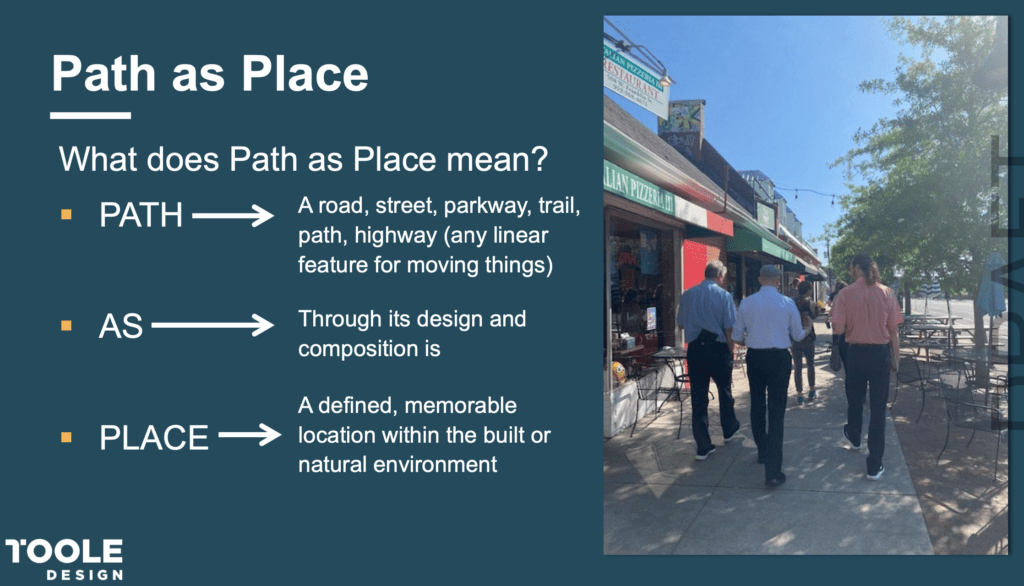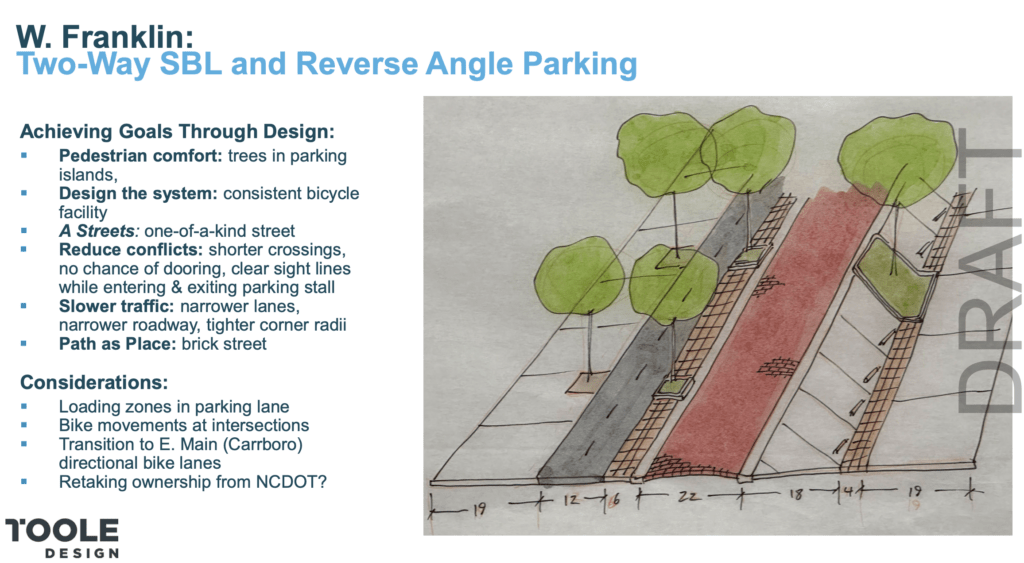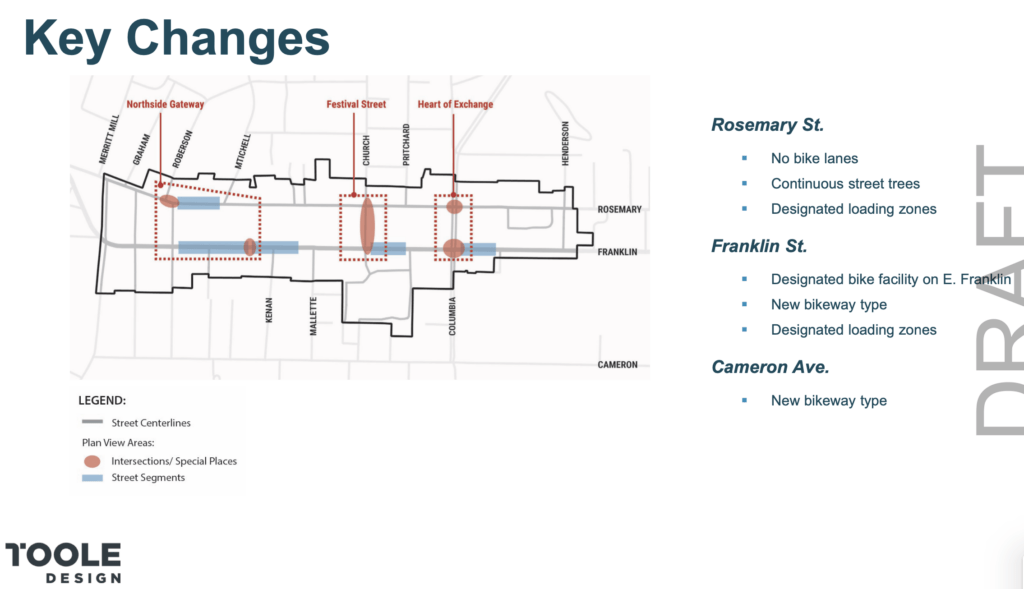Last November, the Chapel Hill Town Council committed $500,000 in American Rescue Plan Act (ARPA) funds to a “Streetscape Enhancement Mobility Plan,” that would focus on how people move around downtown. In February, the town selected Toole Design, a national streetscape design firm that has offices in Raleigh, to conduct a study of downtown streets. As I understand it, several decisions, including whether Chapel Hill should take over the maintenance of Franklin Street from the North Carolina Department of Transportation and the design for new protected bike lanes on Cameron Avenue, were put on hold until the study was complete.
This was designed to be a quick process—focus groups in April, a “big reveal” of its design ideas in May, and a presentation to the Chapel Hill Town Council tonight, June 7. (There are 65 slides in Toole’s draft presentation).
In theory, I should be supportive of this project. Toole seems like just the right consultant for Chapel Hill. On their web site they note that the company “does not engage in work aimed at moving more cars, faster,” which makes them the antithesis of motor vehicle centered planning organizations like the NCDOT (which currently has final say on what happens on Franklin Street).
But after attending the events over the past two months, I’m not convinced that the town needed this particular study at this time. While there are some interesting ideas that Toole is bringing to the table, this study doesn’t seem to be moving us any closer to a downtown that works for everyone. Here’s a few reasons why:
This is a streetscaping proposal. We need a mobility study.

In their presentation, Toole emphasizes what they call “Path as Place,” or, simply, the idea that streets can themselves be destinations, not just a way to get from one place to the next.
As a result, a lot of their proposals are ways to make Franklin and Rosemary more attractive places to spend time. They call for paving the streets with bricks, adding street trees and places for sculptures and monuments, and other improvements to our downtown streets.
There’s not a single dollar sign in the presentation, but we imagine the number is quite high.
In several slides we see the bullet point “Retaking ownership from NCDOT?” An earlier presentation from town staff laid out cost estimates for different options for Franklin and Rosemary, while they are absent in this study. (This is completely understandable, given Toole’s charge, but given the number of things the town has on its plate right now, engaging in this kind of an exercise as a one-off seems a bit extravagent).
And, this study doesn’t tell us much about who goes downtown, how they get there, and why. We have traffic counts from the NCDOT, but we don’t know much time people spend trying to find a place to park, or whether the new bike lanes are attracting new cyclists, or if people realize how easy it is to take the bus downtown (or just use it to get from one end of downtown to the other.)
We need to talk about parking. And transit.

I appreciate the study’s emphasis on pedestrians and people on wheels. The best streets are places where people feel comfortable walking, biking, pushing a stroller, and using a mobility scooter. And Toole’s presentation shows what we can do if we emphasize all users of our downtown streets. (At the same time, removing the bike lanes from Rosemary, as proposed, could be harmful, particularly if it’s not accompanied by improvements in Franklin.)
At the same time, the study seems to wish away how much parking demand shapes our downtown. Currently, our approach to parking encourages the proliferation of surface parking lots, many of which are private, and we fail to adopt many of the best practices that have worked in other communities. For example, Chapel Hill stops charging for street parking at 6 pm but continues charging people to park in its garages until 8 pm. This encourages people to circle the block to find free street parking at rush hour, which makes traffic worse. Extending meter parking to 8 pm, and charging a flat rate for evening parking in our garages, would encourage people to park once and spend more time in our community.
While the study proposes some new approaches to the design of our parking spaces—angle-in parking allows you to create more spaces per block—we need to commit to adopting best practices for the pricing of parking if we’re going to make it easy for people to come downtown. Too many of our side streets downtown are reserved for resident parking, which the town effectively gives away. (A parking space in Chapel Hill is $1,000 or more a year if you rent one from UNC or the town, but the town asks residents to pay just $25/year for a street permit if they live downtown. People over the age of 65 park for free). Let’s fix parking, first. Then we can engage in rethinking our downtown streets.
Transit needs are also neglected in this study. Initially, Toole proposed moving all the buses to Rosemary, which would have introduced logistical and equity challenges. If we want people to come downtown, we need to make it easy to get here on the bus, and that includes designing our streets with the needs of bus riders in mind.
Cameron Avenue is neglected.

As I understand it, Cameron Avenue, the third major east-west street downtown, was originally supposed to be part of the study, which is why plans to build protected bike lanes on the street were delayed. But Toole ended up not including Cameron, despite the fact that this street is probably in the highest need of an attractive bike-friendly design.
Even worse, by adding six to nine months, at least, to the redesign of Cameron Avenue, the town has chosen to leave the street in bad shape even after OWASA finished its years-long project to replace sewer pipes. This summer Chapel Hill is repaving nearby side streets, but Cameron remains a bumpy and unsafe street for cyclists, despite the fact that it is the most heavily used street by cyclists in all of Chapel Hill.
While I believe that many people in Chapel Hill, including our elected officials and town staff, sincerely want to make downtown safer for all, we live in a society that prioritizes cars above all else, even when it doesn’t make sense. We’ve already committed almost $50 million of debt to building a downtown parking garage, and current projections suggest it will be decades before we pay off this debt.
Consolidating the many downtown surface lots into parking garages is good and will allow us to rethink the way we use those (many) lots. But we should also be thinking about ways to provide accessible and reliable options for bikers and pedestrians. Omitting Cameron from the study suggests that the future of Chapel Hill may be one where people walk on brick under towering trees – and they’ll be driving to get there.